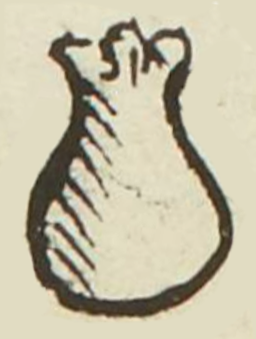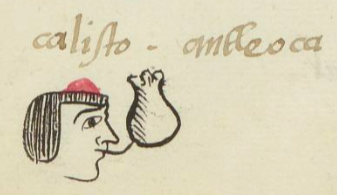Antleyocan (MH895r)
This black-line drawing of the simplex glyph for the possible personal name Antleyocan (perhaps “Full of Nothing” or “Empty”) is attested here as a man’s name. The glyph shows just a frontal view of a bag or sack (perhaps intending xiquipilli). The left side has hatch marks that give it a three-dimensionality, showing Euroopean artistic influences. It is difficult to determine if this bag is empty, which could be suggested by antlein (none), if that is the correct interpretation.
Stephanie Wood
To have an empty xiquipilli is to be without money or other precious things, such as cacao beans or silk seeds, perhaps a reference to poverty. The orthography used in the gloss puts the interpretation in question. Also, the -yocan suffix refers to a place full of something, which might not fit with a personal name.
Stephanie Wood
calisto antleoca
Calixto Antleyocan
Stephanie Wood
1560
Jeff Haskett-Wood
bolsas, vacío, nombres de hombres

antlein, none, https://nahuatl.wired-humanities.org/content/antlein
-yocan, a place “full of”, https://nahuatl.wired-humanities.org/content/yocan
posiblemente, Lleno de Nada, o Vacío
Stephanie Wood
Matrícula de Huexotzinco, folio 895r, World Digital Library, https://www.loc.gov/resource/gdcwdl.wdl_15282/?sp=862&st=image.
This manuscript is hosted by the Library of Congress and the World Digital Library; used here with the Creative Commons, “Attribution-NonCommercial-ShareAlike 3.0 License” (CC-BY-NC-SAq 3.0).





